Share this
Your Complete TikTok Ecommerce Strategy Guide For 2025
by Rin Mosher on Oct. 7, 2024

TikTok's meteoric rise to stardom has transformed the social landscape – and the way growing ecommerce businesses are discovered online. Using features like TikTok Shop, advanced ad formats, and viral trends, a well thought out TikTok ecommerce strategy can be a competitive way to reach engaged audiences from Gen Z to millennials and beyond.
In this article, we explore how to create a winning TikTok ecommerce strategy, outlining the must-have tools and tactics ecommerce businesses can use to make the most of TikTok's growing opportunities in 2025 and beyond.
Why A TikTok Ecommerce Strategy Should Be Your #1 Priority
TikTok's social network currently comprises nearly 2 billion users, and that number grows by the day. Its rise to mainstream popularity has outpaced those of other apps like Facebook and Instagram, which both took years to gain their current statuses. People with TikTok on their phones are reported to use it very frequently - roughly 29% of active users open the app every single day.
TikTok's popularity brings relevance to brands that want to reach new, younger customers. Despite being ranked sixth across the board, it's currently the number one social media app used by individuals aged 16-25. Generation Z makes up about 60% of TikTok's active user base, while millennials follow close behind.
These demographics are proven to be the most tech-savvy and ecommerce-friendly shoppers out there. They were born into a world where online checkouts are the norm, and their preferences are driven by convenience. That’s exactly what TikTok offers, now more than ever with the release of its built-in Shop features.
What Is TikTok Shop?
TikTok Shop is a social commerce platform nested within the social media app TikTok. It allows online merchants to create their own virtual storefronts and catalogs through which users can browse and directly purchase physical products. Links to products can also be directly embedded within videos on the app to make it easier for viewers to buy what they see in their content feeds.
TikTok Shop launched for US-based users in September 2023 after originally being available to merchants in Europe and Asia. The new social commerce platform follows in the footsteps of other major players in the space who have already established their own in-app shopping tab spaces, selling features, and product advertisement options.
How TikTok Ecommerce Is Made Easier With Shop
The beauty of TikTok Shop is that everything stays in one place. With TikTok Shop, sellers can manage their inventory and orders using the same tools they’re already familiar with, such as Shopify or BigCommerce, while users aren’t forced to go through as much trouble during their shopping journey. Payment capabilities in the app itself remove the need for separate tabs and make it more convenient for people to make purchases.
How to Craft a TikTok Ecommerce Strategy
Using TikTok strategically can create business and sales opportunities for ecommerce brands – but those opportunities aren’t guaranteed just by being on the app. TikTok ecommerce success is a matter of putting the right strategies in place from the get-go.
Setting up a TikTok Shop account is just the beginning; after an online store has been connected, you'll still need to get products out in front of shoppers and keep them engaged. Use these tools, tips, and resources to get off to a strong start.
1. Use Content to Reach Your Audience
On TikTok, content is currency. It's what people open the app looking for and is likewise what makes them stay. Your content should be creative, entertaining, and above all else, sales-generating. Taking the time to create specialized, engaging content for your audience can help you better engage them and build a loyal following, which will then play a big part in driving ecommerce sales.
An enhanced AI video generator can make creating engaging, dynamic visuals that captivate audiences fast and easy. The most advanced tools allow brands to translate ideas into professional-grade videos within minutes and without any prior editing experience.
Strategically Select the Types of Content You Create
TikTok is primarily a video-sharing platform, but that’s far from the only medium you have when it comes to connecting with audiences on the app. TikTok accommodates several different types of content, from regular video clips to ecommerce-specific product catalog features.
In-Feed Videos: In-feed videos appear in users’ ‘Following’ and ‘For You Page’ feeds, and can range from 3 seconds to 10 minutes long.
In-feed videos are versatile enough to be used for virtually anything. You could make a long-form video touting the results of a product for a particular demographic or make a short-form video showing how easy it is to use. The options are limitless, while TikTok’s offering of in-app editing tools is always growing.
Text Posts: Set against a background and sound of your choosing, text posts offer an easy way to get simple written messages out to followers.
You might use text posts to announce organizational updates like changes to shipping policies and business leadership, or as a means of sharing quotes and funny updates. A broad range of styling tools makes it easy to frame whatever you have to say the right way.
TikTok LIVEs: TikTok LIVE allows you to broadcast events and discussions to followers in real time. TikTok LIVEs are well suited for creating interactive and engaging experiences with viewers. Q&A sessions, product reviews, and behind-the-scenes looks at the creative process provide a great opportunity to showcase products and services with instant feedback. You can even use OTT live streaming to reach a wider audience and engage with viewers in real-time.
New TikTok LIVE Shopping features allow merchants to display items to viewers in real time. You can use this to create your own ‘Shopping Channel’ experience or as a way to connect what’s being shown on the stream to actual items in a catalog.
Stories: TikTok Stories are short-form posts that only remain visible to the public for a period of 24 hours.
The short-lived nature of Stories is perfect for promoting time-sensitive offers and sales. TikTok even has a Countdown Sticker Interactive Add On to make things all-the-more pressing for buyers.
Leverage User Generated Content
User Generated Content (UGC) is a form of marketing that involves turning customer-created content into promotional material. This can be done in a variety of ways, from encouraging people to post reviews or testimonials on your products or services to asking customers to submit their own video and photo content.
UGC has an excellent ability to get people talking about products, grow hashtags and mentions, and increase overall brand awareness. Just ask @JVNHair – the hair care company draws thousands of new followers to its account by reposting customer-made videos. They illustrate the diversity that JVN’s brand aims to promote while providing social proof of product quality.
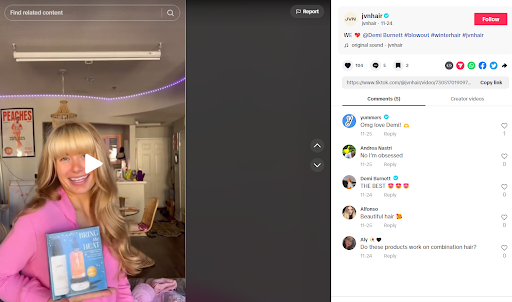
UGC can be sourced directly from customers or through TikTok’s Creator Marketplace. Connected to the TikTok app, the Creator Marketplace enables business owners to find and work with product promoters from around the world.
Partnerships made through the network are official to TikTok and facilitated with built-in campaign management and reporting tools. An ability to search for creators that cater to more than 150 markets in over 50 different languages provides an unprecedented amount of control over who you influence with UGC and how.
Organize Content Well
The types of content you publish shouldn’t just be diverse and strategically selected, but also well-organized. It's best to manage things as if people are seeing your profile for the first time, every time.
This will give people an easy way to find information and allow them to build an understanding of who your brand is and what you’re all about. For example, if you are a fashion outlet, try to break up your posts into categories like new arrivals, behind-the-scenes looks at your team, or influencers wearing products.
Take @TheOrdinary as an example. The wildly popular skincare products company creates playlists to pin groups of topic-specific videos to the top of its profile page. With relevant answers and guidance available in one place, potential customers are enabled to make their first purchase with confidence.
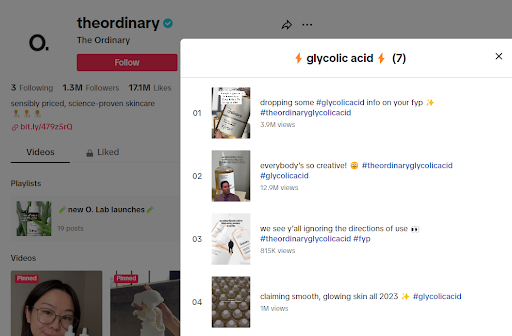
Tap Into the Potential of Hashtags and In-Video SEO
TikTok's hashtags can be considered an organizational system in and of itself, defining content by short phrases and words. Using them properly makes it easier for people to find what they’re searching for while simultaneously boosting the visibility of your brand and posts.
Ecommerce businesses can leverage hashtags in several ways. Depending on your objectives, you might use them to showcase new products or highlight specific product categories such as ‘#tshirts’ or ‘#accessories’. You could also build a hashtag around an event like a sale, or use trending hashtags that are relevant to your industry.
Deploying hashtags the right way increases the chances of your content showing up where it’s most relevant, including on the For You Page of users who engage with videos in the same category.
Adding text to your videos further improves content visibility by providing context for TikTok’s algorithm to use when recommending videos. Part of this algorithm involves a keyword-based system that organizes posts based on the terms they contain. This goes for both post descriptions and text in videos themselves. Apply what you know about SEO to target specific audiences with relevant pieces of content.
2. Make Ads a Part of Your Strategy
While organic content forms the basis of a strong TikTok ecommerce presence, ads are necessary to supplement your organic efforts and bring in extra business.
Understand the Different Types of Ads TikTok Offers
Similarly to other social media platforms like Facebook or Instagram, paid ads on TikTok are mixed in with the organic content feed, known on TikTok as the For You Page.
TikTok offers several types of ad placements on its platform. Each of these placements has a slightly different purpose and offers its own advantages beyond offering extra exposure.
In-Feed Ads: In-feed ads are the most commonly used ad format on TikTok. These are placed directly in between users’ feeds, appearing as short videos or images. They usually feature a call to action (CTA) at the end, such as “swipe up” to visit a website.
Spark Ads: TikTok Spark ads use existing content from a brand's account to create an ad that is shown to users on the TikTok For You Page. These placements look very similar to regular posts, with the only real differences being a small 'Sponsored' banner and the option to add a CTA button.
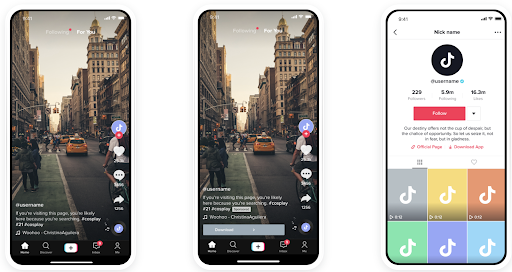
Image courtesy of TikTok
TopView Ads: TopView ads are similar to in-feed ads but specifically appear when users launch the TikTok app. Placements can be either a video or an image that takes up the entire screen. The goal here is to grab users’ attention before they have a chance to engage with anything else.
LIVE Shopping Ads: LIVE ads promote TikTok LIVEs by placing broadcasts in between regular video content on the For You Page. You can use LIVE ads to promote your products with the TikTok LIVE shopping feature.
Branded Hashtag Ads: Branded hashtag ads help promote user-generated content campaigns. Usually limited to a specific time period, these initiatives encourage users to post content related to hashtags that tie back to a business’ profile. This is an effective way for brands to engage with their audience and create a sense of community.
Example
Chipotle’s #GuacDance challenge prompted thousands of users to bust a move for free guacamole on National Avocado Day.
@brentrivera When guacamole is free @chipotle when you order online/in-app on July 31st😍 #GuacDance ad
♬ The Guacamole Song - Dr. Jean
Consult the Creative Center
TikTok’s Creative Center is an amazing resource for brand owners who want to learn more about how the app’s content, feed, and ecommerce features work.
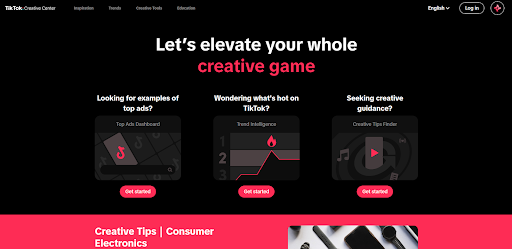
Far from a typical FAQ page, the Creative Center offers advice that ecommerce entrepreneurs can use to their advantage as they strive for popularity on TikTok. There’s an abundance of data available for insights into current trends, top-performing sounds, hashtags, and more.
The ‘Top Ads’ dashboard displays TikTok’s best-performing auction ads to give you a better understanding of who’s doing well and why. Results can be broken down through multiple filters, including country, industry, language, objective, format, and KPIs. You’re even given the option to search based on keywords and brand names, which is invaluable for competitor analysis.
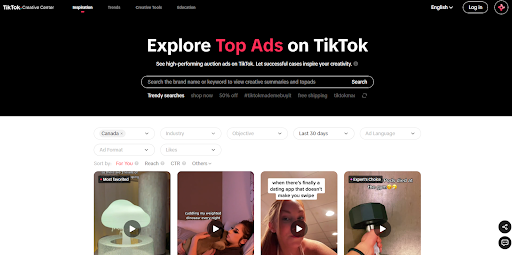
3. Study Your Audience With Analytics Tools
Ads and organic content are only as effective as they are well-informed. Thankfully, TikTok has a wide range of analytics and reporting tools that can give you insight into the performance of your content for better results. By keeping tabs on who is engaging with what you create most, you can adjust both marketing efforts and products to be more appealing.
Post Analytics
Post analytics give account owners an overview of their content’s performance over a period of up to 60 days. Accessible through ‘Creator tools’ > ‘Analytics’, you'll have access to a dashboard that reports key metrics like follower growth, video and profile views, likes, comments, and shares. This is also where analytics for LIVE broadcasts are shown - specifically broken down into attributable followers, views, streaming time, and earnings.
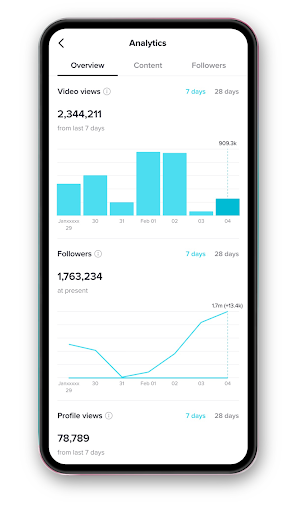 Image courtesy of TikTok
Image courtesy of TikTok
This space is great not only for the insight into performance that it provides but also for the ability to compare data from multiple posts and cross-reference key metrics. After comparing this data, you might notice interesting trends that are hard to identify through the notification center alone. For instance, one month's top uploads could have something in common, like the use of particular hashtags or sounds. Knowing what has driven the success of past content can help you create future content that's even better at selling what your ecommerce store has to offer.
TikTok Ads Manager
TikTok Ads Manager is a control and command center for paid advertising campaigns on the TikTok app. Exclusively available to business accounts, it's where your brand's admin team will go to launch, modify, and manage ads.
The Ads Manager has a range of settings and targeting options that help you determine who sees your ads, when they see them, and how long and often they're seen. Its functionalities extend beyond just setting up campaigns to include comprehensive analytics and optimization capabilities.
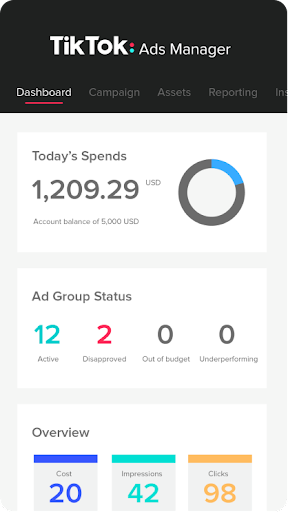 Image courtesy of TikTok
Image courtesy of TikTok
Using the Ads Manager, you have the power to track a broad range of metrics such as impressions, clicks, conversions (or purchases), cost per result (CPR), average order value (AOV), and return on ad spend (ROAS). This data can be used to determine the success of individual campaigns and track trends in users’ buying behavior.
The reporting dashboard allows you to apply dimensions like objective, target country, and gender for an even deeper look into performance. You can also save reports as templates for future use and export them as PDFs or Excel files to be shared with other stakeholders involved in your TikTok shop strategy.
TikTok Pixel
The TikTok Pixel is a tiny piece of code designed to be installed on websites to measure, optimize, and build audiences for in-app ad campaigns. It's not required of TikTok Shop owners, however highly recommended if you want full insight into the connection between your online store and TikTok business profile. With a pixel in place, it becomes much easier to follow customers through the buying process as they engage with content on both channels.
The installation process looks different across ecommerce platforms, so it's recommended to do some research before getting started. The pixel itself can be accessed via TikTok Ads Manager, which is available to all users who have an active ad account. From there, it's simply a case of following the instructions for setup and installation.
Once set up correctly, you'll be able to track events (like product views or purchases) in the pixel dashboard and create custom audiences based on various criteria. This is great for creating retargeting campaigns and for targeting users who are more likely to convert.
4. Meet TikTok Seller Expectations
Every seller on TikTok Shop is expected to adhere to the platform's terms and conditions. Policies exist to protect businesses and buyers alike and are enforced using a point-based system. TikTok has the discretion to issue between 1 and 48 Violation Points for every infraction of its rules.
The enforcement measures vary based on thresholds:
- 12 - 23 points: Temporary restrictions on campaign participation, new listings, and access to TikTok Shop benefits for 7 days
- 24 - 35 points: Restrictions increase to 14 days, impacting order volume limits and campaign participation
- 36 - 47 points: Temporary shop deactivation for 28 days and further campaign restrictions
- 48 points: Permanent suspension and possible legal actions, including reports to authorities
Beyond the immediately noticeable enforcement actions outlined above, failure to follow TikTok’s merchant policies may also indirectly hurt your prospects for sales. Restricted accounts are suppressed in the For You Page – the main place where users discover brands and purchase products. A seven-day, 14-day, or 28-day suspension should therefore be viewed just as much of an opportunity cost as a platform access one.
Know the Rules
It's in your best interest to both know and follow TikTok's policies for store owners. There are rules governing a wide range of issues, from product listings to fulfillment to fraud. All can be found on the TikTok Shop Academy website.
Here's a high-level overview of the key policies you should pay attention to:
- Compliance with advertising standards
- Prohibition of counterfeit or prohibited items
- Accurate representation of products and services
- Timely order fulfillment and shipping
- Customer service obligations and response times
- Adherence to payment processing guidelines
Ignorance is not bliss when it comes to compliance. Familiarizing yourself with the above rules will help you avoid the pitfalls and potential losses that come with repeated violations.
TikTok Shop Service Level Agreements (SLAs)
Service Level Agreements (SLAs) are benchmarks that help define seller performance and expectations. TikTok monitors SLAs using a combination of internal and external audits, in-app reporting, and algorithmic detection methods to ensure a consistent experience for buyers on its platform.
As a TikTok Shop store owner, you should not only know what these metrics are and why they might change but also have a system in place to remain in good standing. See a summary of the three most important SLAs on TikTok Shop along with recommendations on how to meet these expectations effectively below.
Late Dispatch Rate (LDR): Late Dispatch Rate (LDR) measures the percentage of orders that do not reach TTS Shipped or Dispatched status until after the TTS SLA Cut-Off Time within a given evaluation period. TikTok Shop sellers must maintain an LDR of equal to or less than 4%. That means that if you receive 1,000 orders, no more than 40 should be late.
LDR comes down to inventory management, fulfillment turnaround time, and the reliability of shipping options you use. Investments in these areas - as well as ongoing monitoring, evaluation, and improvements - will mitigate the risk of late dispatch.
Valid Tracking Rate (VTR): Valid Tracking Rate (VTR) refers to the percentage of orders that have accurate tracking information provided by the seller. This metric exists to ensure customers can monitor their shipments after purchase. It only applies to sellers who have selected "Ship by Seller" as their shipping option.
Staying under TikTok's VTR limit of 95% is a matter of diligence. You should cross every "t" and dot every "i" when inputting tracking IDs and shipping provider names. Double-check that the tracking numbers you enter are valid and correspond to the shipping labels you have generated every single time.
Seller Fault Cancellation Rate (SFCR): Seller Fault Cancellation Rate (SFCR) tracks the percentage of orders canceled due to issues on the seller's end. This includes reasons like inventory shortages, miscommunication with buyers, or failure to fulfill orders in a timely manner. TikTok Shop requires an SFCR of equal to or less than 2.5%.
You'll save yourself a lot of Violation Points by taking every one of your responsibilities as a seller as seriously as possible. That can look like many things; regularly updating stock levels to reflect actual availability, keeping buyers informed about their order status and ensuring prompt communication with customers.
A Reliable Fulfillment System Is Key to a TikTok Ecommerce Strategy
The above expectations placed upon TikTok Shop store owners makes reliable fulfillment an absolute necessity. Well-defined strategies see that vital order processing responsibilities are always taken care of. A business’ ability to consistently meet SLAs often comes down to the resources they’ve invested in their warehouse infrastructure and teams.
Warehouse Management Software (WMS), lot tracking, and real-time inventory updates all have the potential to make a big difference in efficiency while lessening room for error. Consider hiring a logistics manager to ensure supply chain KPIs remain up to par with TikTok Shop’s standards.
Include a 3PL Fulfillment Company In Your TikTok Ecommerce Strategy
When purchases start pouring in, you'll want a proper logistics system in place to fulfill all of those TikTok Shop orders. A third-party logistics (3PL) service provider can make building one easy. Outsourced solutions offer the opportunity to hand the complicated parts of running an ecommerce business – namely fulfillment, storage, shipping, and returns – over to specialists. Trustworthy 3PLs put in the time and resources necessary for your business to keep turnaround times fast and customer experiences great. Meanwhile, you'll have more bandwidth to put towards TikTok shopping ads, sales strategies, and influencer marketing opportunities.
Ready to take your TikTok sales to the next level? Shipfusion is the fulfillment partner built for rapidly scaling DTC brands who want to grow with TikTok Shop. With our custom-built TikTok Shop integration and dedicated on-site Account Managers, we make it easy for you to manage orders at scale, ensuring a seamless and consistent fulfillment experience across all your channels. Discover how our TikTok Shop order fulfillment services can help you focus on what matters most — growing your business.
Share this
You May Also Like
These Related Articles

TikTok Shop Name Ideas and More Inspiration for 2025

The Best TikTok Shop Items to Sell This BFCM

TikTok Shipping vs Seller Shipping vs FBT: Which Is Best?
- October 2025 (1)
- September 2025 (6)
- August 2025 (8)
- July 2025 (16)
- June 2025 (22)
- May 2025 (27)
- April 2025 (27)
- March 2025 (26)
- February 2025 (26)
- January 2025 (34)
- December 2024 (16)
- November 2024 (22)
- October 2024 (22)
- September 2024 (27)
- August 2024 (9)
- July 2024 (8)
- June 2024 (5)
- May 2024 (8)
- April 2024 (7)
- March 2024 (6)
- February 2024 (6)
- January 2024 (5)
- December 2023 (3)
- November 2023 (3)
- October 2023 (5)
- September 2023 (4)
- August 2023 (2)
- July 2023 (1)
- June 2023 (4)
- March 2023 (2)
- October 2022 (1)
- September 2022 (5)
- August 2022 (4)
- July 2022 (7)
- June 2022 (4)
- May 2022 (4)
- April 2022 (6)
- March 2022 (2)
- February 2022 (1)
- January 2022 (3)
- December 2021 (2)
- November 2021 (4)
- October 2021 (2)
- September 2021 (5)
- August 2021 (4)
- July 2021 (4)
- June 2021 (3)
- May 2021 (2)
- April 2021 (3)
- March 2021 (3)
- February 2021 (3)
- January 2021 (2)
- December 2020 (4)
- November 2020 (2)
- October 2020 (4)
- September 2020 (2)
- July 2020 (5)
- June 2020 (4)
- May 2020 (2)
- April 2020 (2)
- March 2020 (4)
- February 2020 (1)
- December 2019 (1)
- May 2018 (1)
- March 2018 (2)
- February 2018 (3)
- January 2018 (3)
- November 2017 (3)
- July 2017 (4)
- March 2017 (3)
- February 2017 (5)
- January 2017 (3)
- December 2016 (4)
- November 2016 (6)
- October 2016 (6)
- October 2015 (1)
- September 2015 (1)
- June 2015 (3)
- May 2015 (3)
- August 2014 (1)
- July 2014 (1)
- March 2014 (1)
- February 2014 (1)
.png?width=3334&height=468&name=Shipfusion_Logo%20Color%20Light%20(1).png)
.png?width=2850&height=400&name=Shipfusion_Logo%20Color%20Light%20(1).png)